Homemade Sourdough Bread, Step by Step
This post may contain affiliate links. Please read my disclosure policy.
If you love fresh sourdough bread with a golden, crisp crust and a light, airy crumb, this recipe is for you. It’s one of the simplest homemade sourdough bread recipes, and one of the best, too. It requires only 25 minutes of hands-on work and no autolyse or preferment. Below you will find guidance for every step of the way. 🍞🍞🍞
⭐️⭐️⭐️⭐️⭐️ Review:
“Absolutely the best sourdough recipe EVER! I have been baking bread for years (sourdough included,) and things were many times hit or miss. Not with your recipe. You have nailed it. I thank you!” — Rosemary Patterson
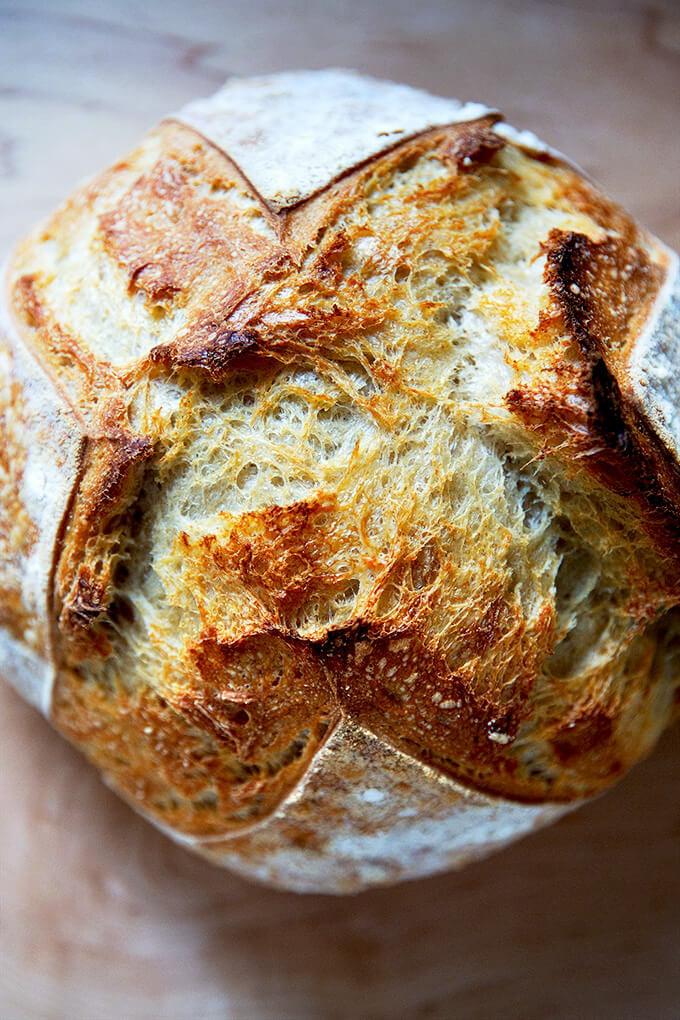
This post will show you how to make the simplest of simple sourdough breads. There is no autolyse or preferment, which means the dough itself comes together in less than five minutes.
For those intimidated by sourdough bread baking, this recipe, as well as this sourdough focaccia recipe, are the recipes I suggest making first, both for their simplicity and flavor. Another great beginner’s bread recipe to try is this overnight, refrigerator focaccia or my mother’s simple peasant bread recipe, both of which require minimal effort but yield spectacular results.
This post is divided into 13 sections:
- What is Sourdough Bread?
- What is a Sourdough Starter?
- How to Feed a Sourdough Starter
- When is My Starter Ready to Be Used?
- Equipment
- How to Make Sourdough Bread: A 5-Step Overview
- How this Sourdough Bread Recipe Differs From Others
- Simple Sourdough Bread: A Step-by-Step Guide
- #1 Sourdough Bread Baking Tip
- Troubleshooting: Where Sourdough Goes Wrong
- Sourdough Baking Resources
- Other Sourdough Bread Recipes to Make
- Sourdough Bread Baking Schedule
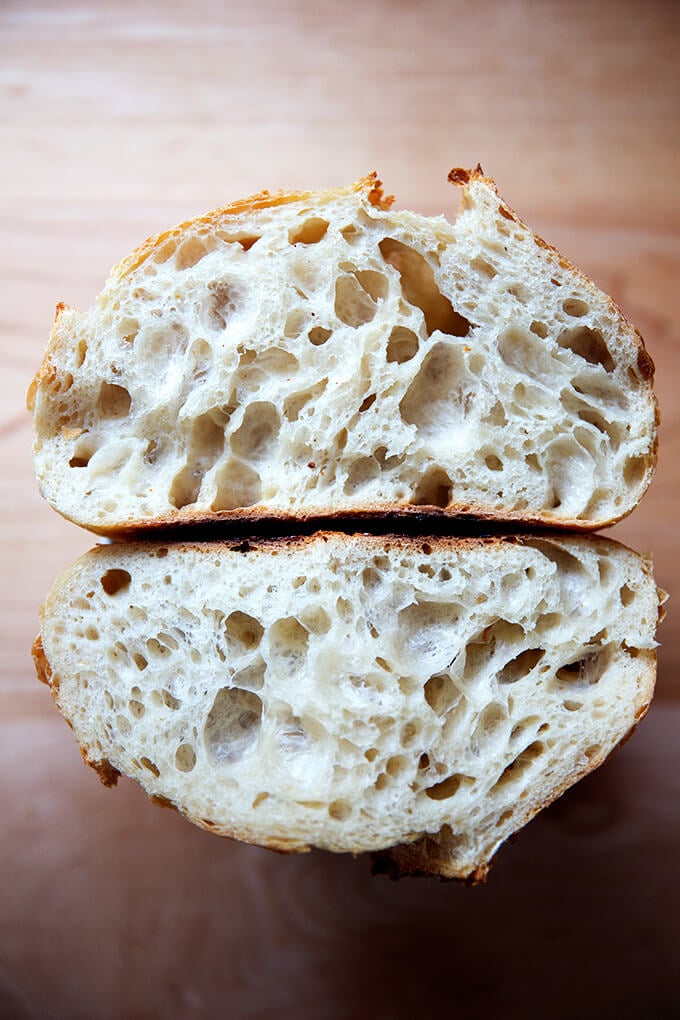
What is Sourdough Bread?
Sourdough bread is bread that has been leavened naturally, meaning it has been leavened by a sourdough starter as opposed to by commercial yeast or a chemical leavening agent such as baking powder or baking soda.
What is a Sourdough Starter?
A sourdough starter is a fermented mix of flour and water containing wild yeast and bacteria (lactobacilli). Provided it is healthy and active, a sourdough starter is what will make your bread rise.
You can make a sourdough starter from scratch in just about a week. I only recommend doing so if it currently is summer (or a very warm fall) where you are. While it is immensely satisfying to build a starter from scratch and subsequently use it to make a beautiful loaf of bread, I am a huge proponent of purchasing one for a few reasons, namely: when you purchase a starter, you are guaranteed to have a strong, vigorous starter from the start. In other words, you can start baking with confidence right away.
Here are three online sources for reasonably priced sourdough starters:
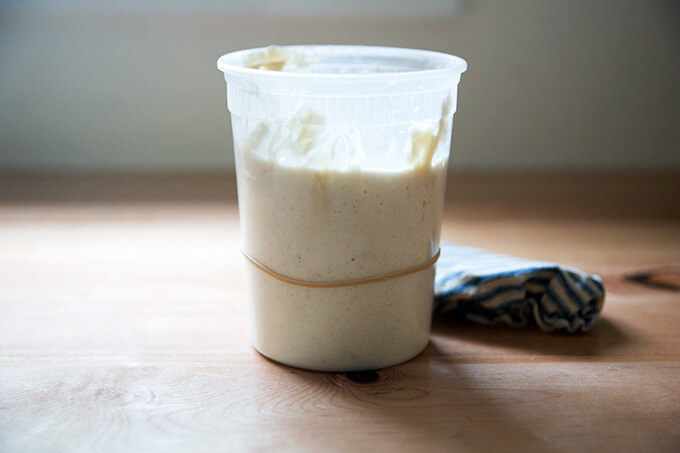
How to Feed a Sourdough Starter
In order to keep your starter alive, you have to feed it — it’s not unlike having a pet, but know this: caring for a sourdough starter is akin to caring for a very low maintenance pet, one that requires feeding only once every two to three weeks to stay alive, but one that requires feeding much more regularly if you like to bake frequently.
When I am not baking regularly, I store my starter in the fridge in the above-pictured vessel with its lid on. As noted above it can hang out there for 2-3 weeks (if not longer) without being touched. To wake it up or activate it, I like to feed it twice before using it. Often I’ll remove it from the fridge after dinner and feed it: this involves discarding most of it and replenishing it with equal parts by weight flour and water. (Please read this post, which explains in detail how to activate, feed, and maintain a starter.)
I will repeat this process in the morning — discard most of it; then replenish it with equal parts by weight flour and water. By midday, or when my starter has doubled in volume, it is ready to be used.
To store your starter, you should feed it, let it rise till it nearly doubles; then cover it and stash it in the fridge for 2 to 3 weeks until you are ready to use it again.
How Do I Know if My Starter is Ready to be Used?
If your starter doubles (or triples!) in volume within 4 to 8 hours after a feeding, it is ready to go. And ideally, you want to use your starter 4 to 8 hours after you feed it or when it has doubled. Every time I feed my starter, I place a rubber band around the vessel it is in to mark its height. This helps me see when it has doubled in volume and is, therefore, ready to be used.
If your starter is not doubling within 4 to 8 hours of feeding it, you should spend a few days strengthening it. This will involve discarding most of it — truly, don’t be afraid to be aggressive with how much you are discarding — and replenishing it with equal parts by weight flour and water. If you do this twice a day for several days, your starter will be in great shape.
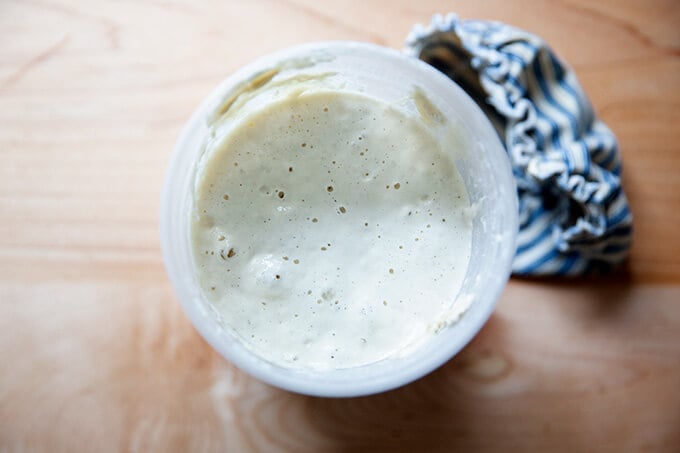
What Equipment Do I Need?
At a minimum, you’ll need:
- a sourdough starter (see above)
- flour, bread flour if possible, my preference is King Arthur Flour
- salt
- water
Ideally, you’ll also have:
- digital scale
- straight-sided vessel for monitoring the bulk fementation
- bench scraper
- flour sack towels
- parchment paper
- banneton, such as this one or this one
- razor blade
- heavy lidded vessel, such as this one or this one
How to Make Sourdough Bread: A 5-Step Overview
There are essentially 5 steps to making sourdough bread. Each of these steps is explained in more detail below.
- Mix the Dough: This is simply a matter of combining water, sourdough starter, salt and flour in bowl, and stirring to form a sticky dough ball.
- Bulk Fermentation: This is just a fancy name for the first rise. During the first two hours of the bulk fermentation, you’ll perform a series of stretches and folds, which will give the dough strength and elasticity.
- Shape + Bench Rest: This step ends the bulk fermentation. You’ll shape the dough, let it rest, then shape it once more.
- Proofing the Dough: In this recipe, you’ll cold proof the dough in the fridge, ideally for 24 to 48 hours, though you can get away with a shorter proof.
- Scoring + Baking the Dough: After the dough has proofed, you’ll turn it out onto a piece of parchment paper, score it; then transfer it to a preheated baking vessel.
How This Sourdough Bread Recipe Differs From Others
This recipe differs from others in three main ways:
- No Autolyse. Why? I’ve never found employing an autolyse makes a big difference in the final texture of the bread, and I find the process of doing an autoylse frankly to be kind of a pain. What is an autolyse? Autolyse is a technique that calls for mixing flour and water together and allowing them to sit for several hours before adding the salt and sourdough starter. This process allows gluten to develop in dough prior to mixing. It also makes the dough more extensible. This is due to the hydrating effects of soaking the flour, as well as — and this is getting a bit scientific — from the enzymatic activity of protease, which breaks down some of the gluten that forms as the dough hydrates. This process weakens the dough’s elasticity, in turn increasing its extensibility. If you are after a super open crumb, autolyse is something to consider.
- 50% (roughly) Increase in Volume. If you come from the yeast-leavened bread world, you are accustomed to letting your dough double in volume during the first rise. When I first got into sourdough, I was applying this same method, and while I had success, I realized I was often letting my dough overferment — I was pushing the bulk fermentation too far. As soon as I stopped the bulk fermentation when the dough increased by 50-75% in volume, I got a much better oven spring.
- Long Cold Proof. After the bulk fermentation, you’ll shape the dough, and store it in the fridge ideally for 24 hours but it can hang out there for 48 hours or even a bit longer. This long, cold proof will make for a much lighter, open, airy crumb. (Note: If you were to leave the dough in the fridge for 12 hours or less, which you can do, the crumb will be tighter and denser.) After you remove the dough from the fridge, you score it, and transfer it immediately to the oven — there is no need to do a room temperature proof first.
Simple Sourdough Bread: A Step-by-Step Guide
Mix the dough.
To start, pour 375 grams of water into a bowl:

Add 50 to 100 grams of sourdough starter.
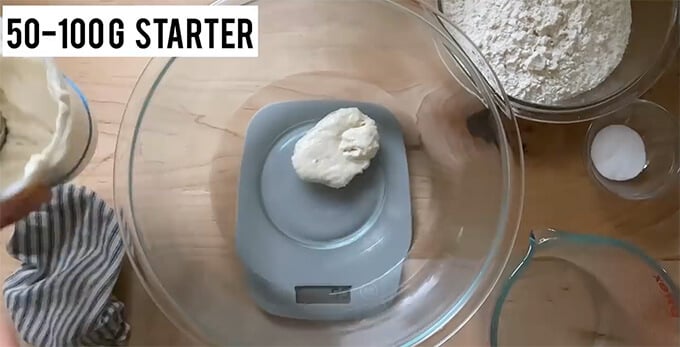
Stir to combine; then add 11 grams of salt:
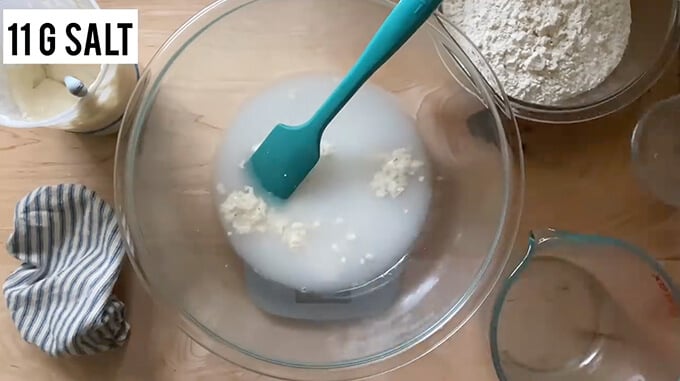
Finally, add 500 grams of bread flour:
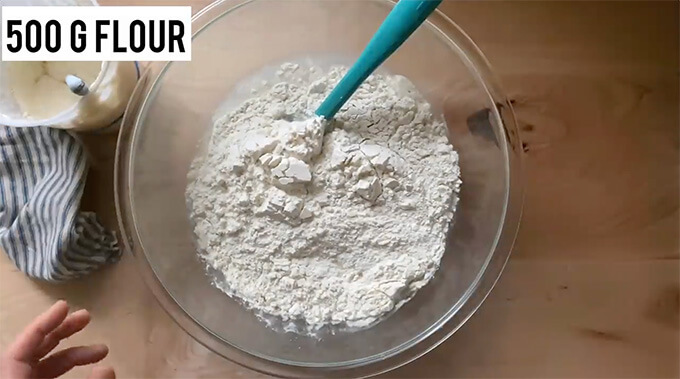
Stir to combine:
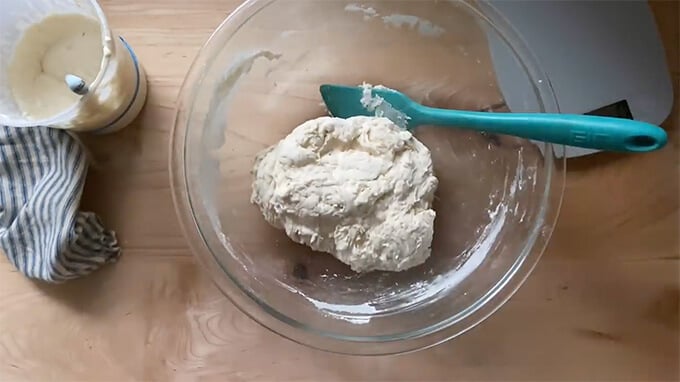
Let it Rise. (Bulk Fermentation)
Transfer the dough to a straight-sided vessel. Cover it, and let it rest for 30 minutes.
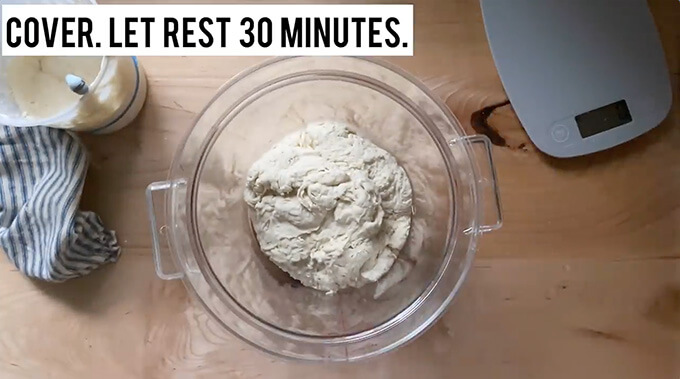
Perform a set of stretches and folds:
If time permits, perform four total sets of stretches and folds every 30 minutes for the first 2 hours. You should notice the dough getting stronger and more elastic with every set of stretches and folds. This is the 4th set:
After the 4th set of stretches and folds, cover the vessel — I love these Dot and Army cloth bowl covers for this — and set it aside until it increases in volume by 50% or so.
How long should the bulk fermentation take?
The time will vary depending primarily on the strength of your starter and the temperature of your kitchen. Rather than rely on a time period, however, you should rely on visual cues.
This video shows the dough nearly doubling (increasing by 100%) in volume, but the more I bake sourdough, the more I realize I have better success when I stop the bulk fermentation when the dough increases by 50%. It may take some trial and error to know what works best for you. You may find a 75% increase in volume is best or you may find that to be too long. Sourdough is all about experimenting and adapting based on your experiences.
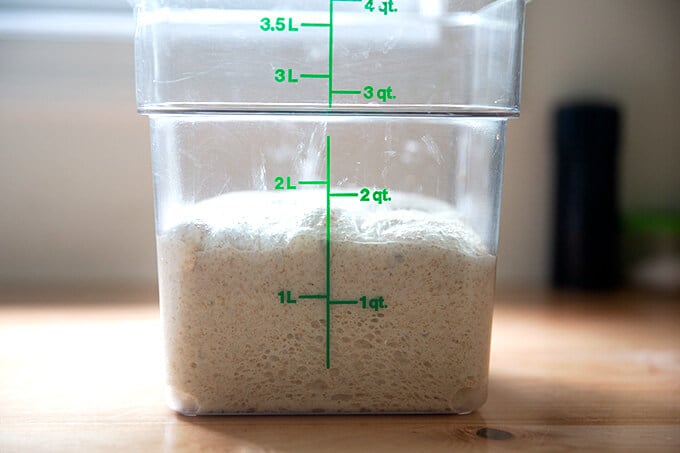
Shaping
Turn the dough out onto a lightly floured work surface:
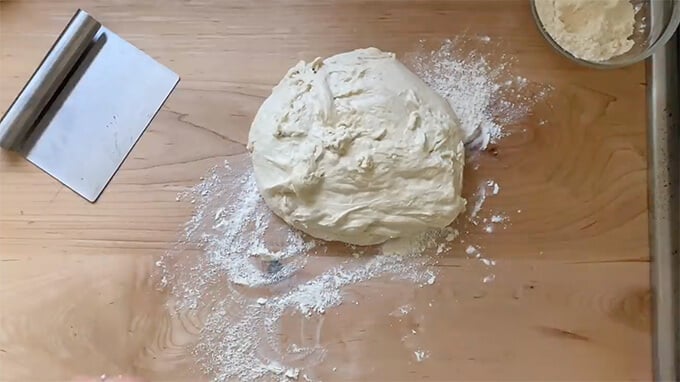
Shape the dough gently into a round and let it rest for 20-40 minutes. This is called the bench rest.
Meanwhile, prepare a bowl or banneton with a flour sack towel and rice flour.
Proofing
Shape the round again; then place in prepared bowl for proofing. Transfer to fridge for 12 to 48 hours.
Bake It.
Remove bowl from fridge, and turn it out onto a sheet of parchment paper.
Score it.
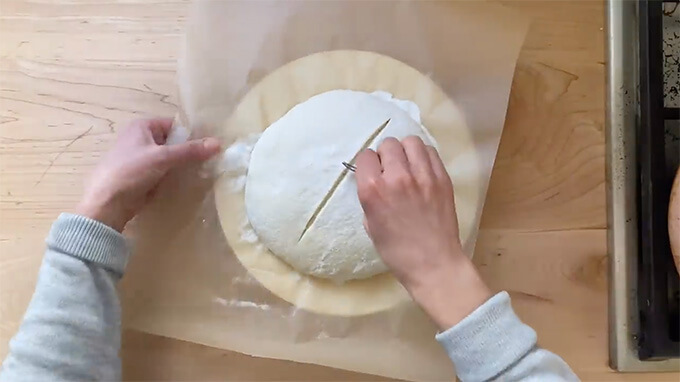
Transfer to preheated Dutch oven. Bake covered at 450ºF for 30 minutes; uncover, lower the temperature to 400ºF, and bake for 15 minutes more:
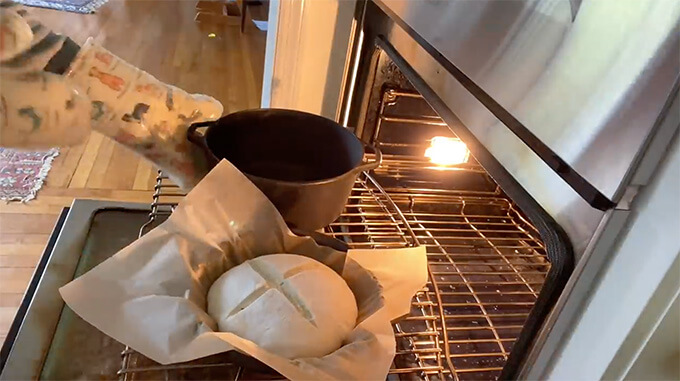
Remove from oven and let cool one hour before slicing.
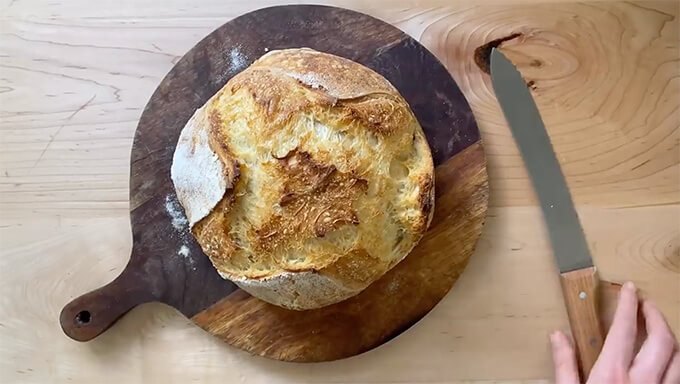
You’ll need a sharp knife (like this one or this one) when it’s time to slice:
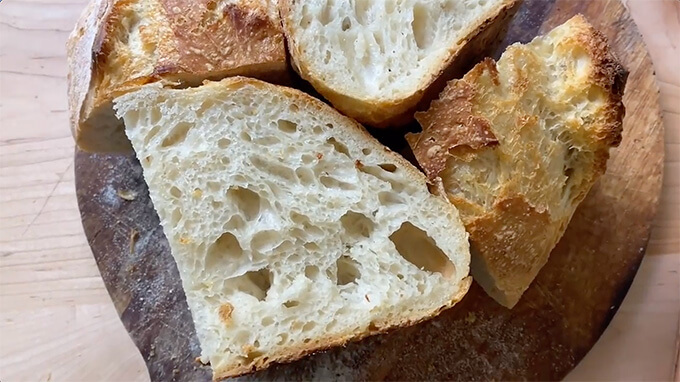
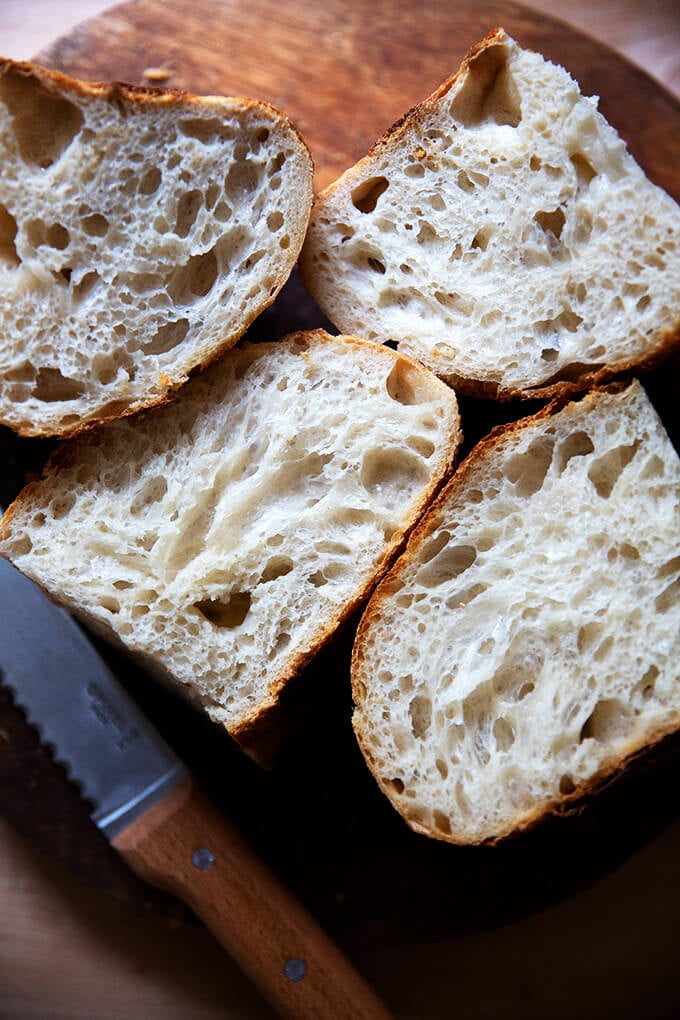
#1 Sourdough Bread Baking Tip
The refrigerator is your friend. Use it.
The most common mistake I see people make when making sourdough bread is letting the bulk fermentation go too long. They mix the dough at night; then wake up to dough that has tripled in volume and is a sticky mess.
To prevent over fermenting your dough, use your refrigerator as needed. After you complete the 4 sets of stretches and folds, you can put your dough in the fridge at any time. If you are tired and need to go to bed, transfer the dough to the refrigerator; then pick up where you left off in the morning: remove the dough from the fridge and let it continue to rise until it increases in volume by roughly 50%.
To accurately gauge when your dough has risen to roughly 50% in volume, I highly recommend investing in a straight-sided vessel such as this 4-qt Cambro (or this one, which is BPA-free!). When dough rises in a bowl, judging when it has risen sufficiently is tricky. There’s no question with a straight-sided vessel.

Troubleshooting: Where Sourdough Goes Wrong?
If you have ever had trouble baking sourdough bread, your issues likely stem from one of four places:
- Using a weak starter or not using starter at its peak.
- Using too much water relative to the flour.
- Over fermentation: letting the bulk fermentation (first rise) go too long.
- Using too much whole wheat flour, rye flour, or freshly milled flour.
I address each of these issues in this post: Why is my sourdough so sticky? 4 Common Mistakes, so please give it a read if you’ve had trouble with sourdough bread baking.
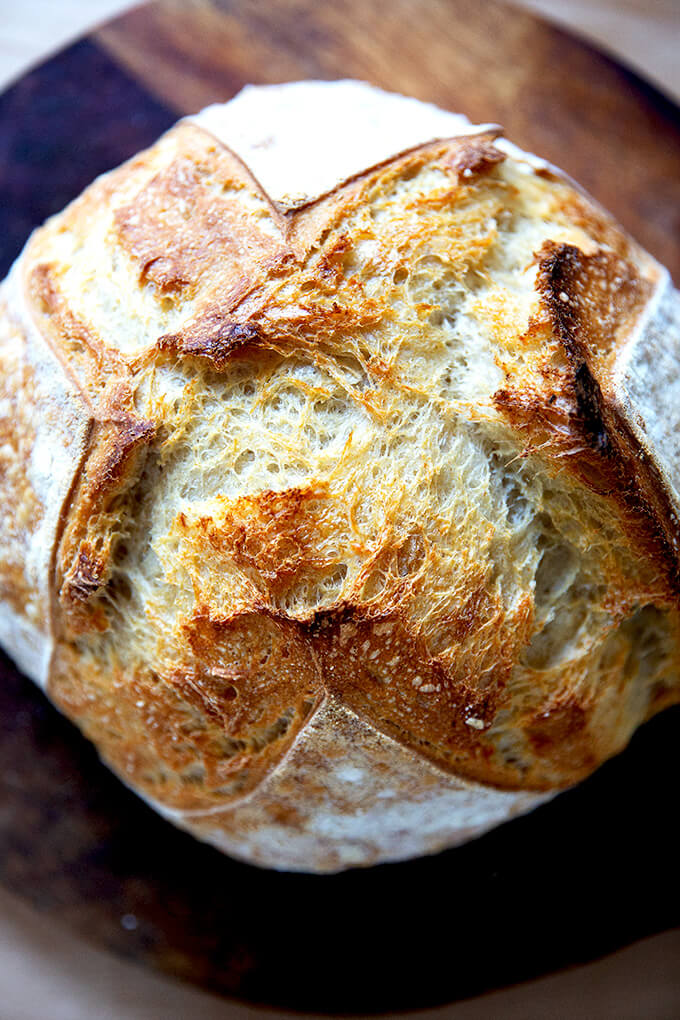
Sourdough Resources
- Sourdough Troubleshooting: This post addresses 4 common mistakes people make when baking sourdough bread and answers many FAQ’s as well.
- The Nutritional Benefits of Sourdough Bread + 6 Healthy Toast Topping Ideas
- Feeding Your Sourdough Starter
- Essential Equipment For Sourdough Bread Baking
- A tip for getting a more open crumb? Shape a batard as opposed to a round:
Other Sourdough Bread Recipes to Make
- Simple Sourdough Focaccia
- Sourdough Bread, Whole Wheat-ish
- Simple Sourdough Pizza
- Sourdough Detroit-Style Pizza
- Simple Sourdough Sandwich (or Toasting) Bread
- Sourdough Ciabatta
- Two Sourdough Discard Recipes: Sourdough Flour Tortillas & Irish Soda Bread
Sourdough Bread Baking Schedule
If you are new to sourdough bread baking, the timing of it all may feel overwhelming — you may find yourself asking: How can I do this without baking at midnight?
It’s a very good question! As noted above, your biggest friend when it comes to sourdough bread baking is your refrigerator. If after you’ve performed your stretches and folds, you don’t have time to stay up for the dough to complete the bulk fermentation, stick the vessel in the fridge and pick up where you left off the next day or the day after that.
Here is a rough schedule I like to follow. Adapt it to work for you:
Wednesday Evening: Remove starter from fridge. Feed it by discarding most of it and replenishing it with equal parts by weight flour and water.
Thursday Morning: Feed starter by discarding most of it and replenishing it with equal parts by weight flour and water.
Thursday Afternoon: Mix dough, let it rise. On Thursday evening, when the dough has completed the bulk fermentation, I’ll shape it and stick it in the fridge to proof. (As noted: If the dough hasn’t completed the bulk fermentation, I’ll stick the vessel in the fridge, and pick up where I left off the following day.)
Friday Evening or Saturday Morning: Score and Bake it. There is no need to let the dough come to room temperature before baking it. Simply remove it from the fridge, turn it out, score it, and bake it!
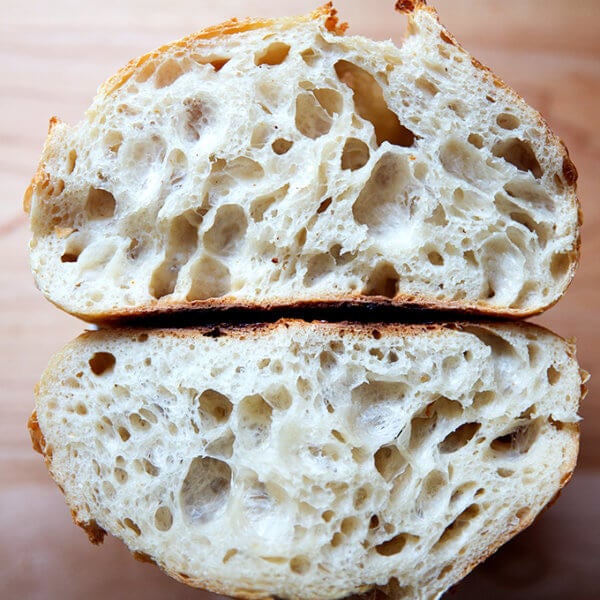
Homemade Sourdough Bread, Step by Step
- Total Time: 18 hours 45 minutes
- Yield: 1 loaf
Description
Inspired by The Clever Carrot
If you are new to sourdough, watch the step-by-step video here: Simple Sourdough Bread or in the post above.
Troubleshooting: If you have issues with your dough being too sticky, please read this post: Why is my sourdough so sticky? The 4 common mistakes.
Notes:
- You need an active sourdough starter. I have had success activating starters from:
- As always, I highly recommend investing in a digital scale before beginning any bread baking adventure.
- This is the Dutch Oven I use for sourdough bread. I used this Dutch oven for years, and it’s a great one, too.
- Flour sack towels are a great investment because they ensure your dough will not stick while it is proofing.
- I love using rice flour for dusting (as opposed to ap or bread flour) because it doesn’t burn. When you use a flour sack towel, however, you don’t need to use any flour.
- Find all of my sourdough essentials here: Essential Equipment For Sourdough Bread Baking
- I love a high-hydration dough, and I have great success using 380 grams of water in this recipe, so feel free to play around and push the hydration here.
- Salt: I have had success using both kosher salt and fine sea salt here. When I use kosher salt, I use the Diamond Crystal brand. When I use sea salt, I use the Baleine Fine brand. Regardless of the brand, I use 12 grams.
- Shaping: If you’re looking to get a more open crumb, try shaping a batard (as opposed to a round). Watch this video for guidance. Also: The recipe below follows the traditional shape once, rest, then shape again method. I often skip the preshape now and simply shape the dough once. I still get a nice open crumb.
How much Sourdough Starter to Use?
- Because my kitchen is cold for much of the year, I like using 100 g (1/2 cup) of starter as opposed to 50 g (1/4 cup). When determining how much starter to use, consider a few things: If you live in a warm, humid environment, 50 g should suffice. If you plan on doing an overnight rise, 50 g also should suffice. If you want to speed things up or if you live in a cold environment, consider using 100 g starter. Note: If you use 100 g of starter, your dough may rise more quickly, so keep an eye on it. As always, rely on the visual cues (increasing in volume by 50%) when determining when the bulk fermentation is done.
- A straight-sided vessel makes monitoring the bulk fermentation especially easy because it allows you to see when your dough has truly doubled.
Ingredients
- 50 – 100 g (1⁄4 – 1/2 cup) bubbly, active starter — I always use 100 grams, see notes above
- 375 g (1 1/2 cups plus 1 tbsp) warm water, or more, see notes above
- 500 g (4 cups plus 2 tbsp) bread flour
- 9 to 12 g (1.5 – 2.5 teaspoons) fine sea salt, see notes above
Instructions
- Make the dough: Whisk the starter and water together in a large bowl with a fork or spatula. Add the flour and salt. Mix to combine, finishing by hand if necessary to form a rough dough. Cover with a damp towel and let rest for 30 minutes.
- Stretch and fold: After 30 minutes, grab a corner of the dough and pull it up and into the center. Repeat until you’ve performed this series of folds 4 to 5 times with the dough. Let dough rest for another 30 minutes and repeat the stretching and folding action. If you have the time: do this twice more for a total of 4 times in 2 hours. Note: Even if you can only perform one series of stretches and folds, your dough will benefit. So don’t worry if you have to run off shortly after you mix the dough.
- Bulk Fermentation (first rise): Cover the bowl with a towel and let rise at room temperature, about 8 to 10 hours at 70°F (21°C) or even less if you live in a warm environment. The dough is ready when it has increased by 50% in volume, has a few bubbles on the surface, and jiggles when you move the bowl from side to side. (UPDATE: In the past I have recommended letting the dough rise until it doubles in volume. If you’ve had success with this, continue to let the dough double. Recently, I have been stopping the bulk fermentation when the dough increases by 50% in volume, and I feel I am actually getting better oven spring in the end.) (Note regarding timing: If you are using 100 g of starter, the bulk fermentation may take less than 8 to 10 hours. If you live in a warm, humid environment, the bulk fermentation may take even less time. In the late spring/early summer, for example, my kitchen is 78ºF and the bulk fermentation takes 6 hours. It is best to rely on visual cues (increase in volume by roughly 50%) as opposed to time to determine when the bulk fermentation is done. A straight-sided vessel makes monitoring the bulk fermentation especially easy because it allows you to see when your dough has truly increased in volume by 50%.)
- Shape (See notes above): Coax the dough onto a lightly floured surface. Gently shape it into a round: fold the top down to the center, turn the dough, fold the top down to the center, turn the dough; repeat until you’ve come full circle. If you have a bench scraper, use it to push and pull the dough to create tension.
- Rest: Let the dough rest seam side up rest for 30 minutes. Meanwhile, line an 8-inch (20-cm) bowl or proofing basket with a towel (flour sack towels are ideal) and dust with flour (preferably rice flour, which doesn’t burn the way all-purpose flour does). Using a bench scraper or your hands, shape it again as described in step 4. Place the round into your lined bowl, seam side up.
- Proof (second rise): Cover the dough and refrigerate for 1 hour or for as long as 48 hours. (Note: I prefer to let this dough proof for at least 24 hours prior to baking. See video for the difference in the crumb of a loaf that has proofed for 6 hours vs one that has proofed for 24 hours. If you choose to proof the dough in the fridge for an extended period of time, you may want to tuck it into a loosely tied bag — produce bags from the grocery store are great for this purpose — to ensure the dough does not dry out. The original recipe calls for a 1-hour rise, and if you have had success doing that, by all means, keep doing it.)
- Place a Dutch oven in your oven, and preheat your oven to 550°F (290°C). Cut a piece of parchment to fit the size of your baking pot.
- Score: Place the parchment over the dough and invert the bowl to release. Using the tip of a small knife or a razor blade, score the dough however you wish — a simple “X” is nice. Use the parchment to carefully transfer the dough into the preheated baking pot.
- Bake: Lower the oven to temperature to 450ºF (230ºC). Carefully cover the pot. Bake the dough for 30 minutes, covered. Remove the lid, lower the temperature to 400ºF (200ºC) and continue to bake for 10 – 15 minutes more. If necessary, lift the loaf out of the pot, and bake directly on the oven rack for the last 5 to 10 minutes. Cool on a wire rack for 1 hour before slicing.
- This loaf will stay fresh up to 3 days stored at room temperature in an airtight plastic bag or container. It freezes beautifully, too.
Notes
- This recipe has been adapted from Artisan Sourdough Made Simple. Changes I have made to the original recipe include:
- Using 11 g salt as opposed to 9 g.
- Performing 4 stretch and folds during the first 2 hours of the bulk fermentation, which build strength in the dough.
- Doing a cold proof for at least 24 hours before baking, which produces a lighter airier crumb. In the video, you can see the difference between the crumb of a loaf that has proofed for only 6 hours vs a loaf that has proofed for 24 hours.
- Finally, I like preheating my Dutch oven, which makes a crisper crust.
- Prep Time: 18 hours
- Cook Time: 45 minutes
- Category: Bread
- Method: Oven
- Cuisine: American
This post may contain affiliate links. Please read my disclosure policy.

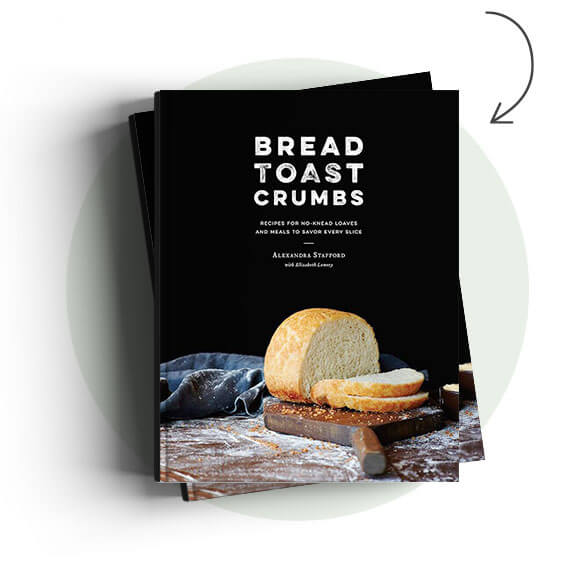




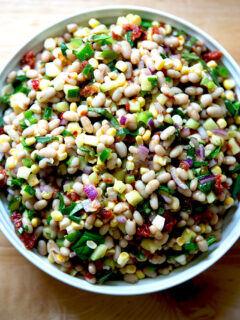
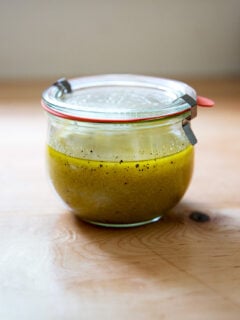



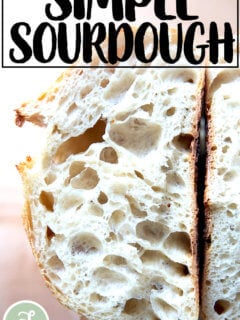
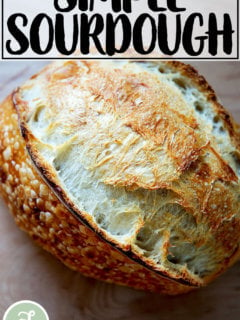
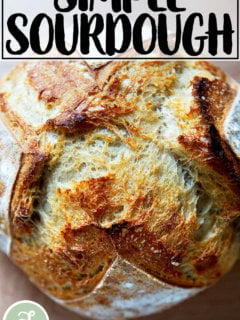
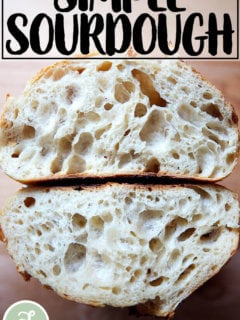
3,017 Comments on “Homemade Sourdough Bread, Step by Step”
Oh my. I am a newbie at making sourdough. I had never made a loaf before a couple of days ago. This just happened to be the first recipe I found and I am so glad it was. The step-by-step instructions along with the pictures/videos really helped my confidence, and the bread itself turned out BEAUTIFULLY! It was so delicious that it reminded me of bread you get before your meal at a restaurant. Thank you so much for this!
So nice to read all of this! Thanks so much for writing, Alexandra. Happy holidays!
Absolutely love this recipe. This was my first time making sour dough. I began my starter 10 days prior and made sure it was good and hungry when I brought the dough together. It’s colder and dryer in our home right now, but I wanted to ferment it overnight so I used 1/4 cup of my starter. For the second proofing I left it in the fridge for a full 24 hours.
The loaf is just stunning and so fragrant. I can hear it crackling as it cools. Can’t wait to cut into it!
Wonderful to read this, Ashlee! Thanks so much for writing and sharing your notes. Happy baking!
The crackling a loaf makes as it’s cooling is often referred to as “singing”. I love that and always listen for it! Hard to wait the full hour to start eating it. Great recipe and so easy! Your changes make a huge difference!
I can’t get my dough into a ball that stays in shape on the rest after the shaping that comes after the bulk rise. It’s sticky and I can’t get tension. It just flattens out. Am I using too much water? I weigh it but I also live in the rain rainy PNW.
It’s possible you need to reduce the water from the start given your humid environment. It’s also possible that the dough over fermented. It is completely slack and without strength and structure?
Curious what your recommendation would be if your dough comes out completely slack and without strength and structure? I love your recipe and have made it dozens of times so i thought i would do some experimenting w/ 80% hydration but I couldnt properly shape it as Jessica stated. Did i need to work the dough more to add structure?
Hi! Apologies for the delay here. A few thoughts: do you think the dough is super slack because of all of the water or did it over-ferment during the bulk fermentation? I’m not sure adding more stretches and folds would help build any more strength. If your dough won’t form a ball, you can definitely bake it in a loaf pan, and it will be delicious.
Hi!! I love all your bread recipes (sourdough focaccia is one of my favorites)! I was wondering if you have any tips on how to make the bottom of this loaf not so hard? I can slice a piece with my bread knife but end up having to use my hands to break it off. Any tips are greatly appreciated!
Hi Kimberly! Great to hear 🙂 Here are some thoughts:
If you are using a preheated Dutch oven, consider lowering the temperature.
Before you make changes to the temperature, however, next time you bake, check the dough after 30 minutes. If the dough is browning too much on the bottom, you know that it’s happening during these first 30 minutes, in which case, you should lower the temperature from the start. Decrease it by 25ºF.
If the dough is not browning, then you know the burning is happening during the last 15-20 minutes of baking, in which case you could remove the loaf from the pot after 30 minutes and bake it on a sheet pan.
Another option: place your Dutch oven on two sheet pans. I do this with challah to prevent the bottom from burning. The extra layer of sheet pans will prevent the bottom of your sourdough from burning, too.
Another option: place your Dutch oven on a broiling pan.
Finally: Use rice flour for dusting — it makes all the difference. It does not burn the way wheat flour does. It also doesn’t coat the loaves with an unpleasant raw flour taste. One bag will last you a long time.
I’ve made 43 loaves of this recipe in my Dutch oven so far, following your recipe with only minor experiments with starter and salt quantity and baking time, and they’ve been fantastic.
Question: my wife asked if I could cut the recipe in half and make two smaller loaves, one at a time. Would you recommend any changes in the 450 and 400 degree baking times?
Thanks! I love your website!
So nice to hear this, John! Yes, you absolutely can bake two smaller loaves one at a time. The baking time will be similar. I would start with baking the loaf covered fro 20 minutes; uncover, then bake for 10 or so minutes more — remove it when it looks browned to your liking.
Thank you for your kind words. Happy New Year!
Love this website, seen it before so thought I’d try this recipe. Used 100g starter and after four stretch and folds, I went out for a couple of hours, When I came back the dough was bubbly and had risen nearly 75%. So I turned it out to shape but it was very sticky and slack. I shaped it as best I could without over-working and put it in a banneton dusted with rice flour for 24 hours. It stuck to the banneton and flattened out like a pancake when I took it out. It rose about four inches when baked with plenty of bubbles and tasted great but looked more like a flying saucer with a slightly rubbery crumb. My starter is strong (been using it in a bread maker for a couple of years) so think I’ll reduce the mix to 70% hydration next time. One suggestion: a point list recipe summary at the end for quick reference would be good.
Hi Peter,
Bummer about the sticking and slack dough… it sounds as though it may have over fermented a bit during the bulk fermentation. Reducing the water from the start is a good idea, and I think shortening the bulk fermentation might be essential given your strong starter.
Newbie here. Trying your recipe next as my first four tries with another recipe were complete failures (unless one is looking to bake sourdough door stops, lol).
Question: After I shape the loaf (after bulk fermentation) it’s going to be pretty knocked down (even if I’m gentle) and nothing like a doubled yeast bread loaf.
Am I correctly understanding that after the final shape, you don’t let it rest/rise a second time and immediately put it into the fridge for 24 hours and then bake immediately?
The recipe that’s super popular but has been failing me calls for that and the refrigerated loaves are pretty flat, and they dont’ change much upon baking. Thus the doorstop specialty I seem to becoming an expert at …
Thanks in advance! Hope I can get something to work eventually. My starter is the bomb. Fresh top-quality flour. Good water. It’s clearly something else going wrong but after several wasted bags of premium flour, it’s pretty discouraging.
Flat seems to be my specialty even though the dough feesl fantastic while stretching/folding. Incrases in size beautifully but once I shape it, it consistently stays flat and never gets better …
Sigh.
Hi Robin,
Apologies for the delay here. Regarding your question: Am I correctly understanding that after the final shape, you don’t let it rest/rise a second time and immediately put it into the fridge for 24 hours and then bake immediately? Yes, that is correct.
Regarding your troubles, it could stem from so many spots. What types of flour are you using to feed your starter? Are you using a scale to measure? Is the starter doubling in volume within 6 to 8 hours of a feeding?
Thanks so much! Made my first successful loaf of sourdough. Too bad I can’t attach a picture
Great to hear! Thanks so much for writing 🙂
Hi. I’ve had success using your recipe. Have you ever doubled the recipe and then made two loaves? I usually try to make two loaves when I bake. I wasn’t sure if having a much larger amount of dough would make the stretches less effective. Thanks.
You can definitely double! I like to keep the dough in a large bowl during the stretches and folds — it’s easier than the straight-sided vessel — then I’ll transfer it to the straight-sided vessel once the stretches and folds are complete.
I’ve made this loaf a few times and it always turns out beautifully. This last time, I let it rise only 7 hours for the bulk fermentation. It looked like it doubled so I took it out and it’s way stickier than it usually is. Does this mean it didn’t rise enough? I’m going to do the 2nd rise anyways but not sure it will turn out. Next time in this situation, should I put it back in its bowl and let it rise for a few more hours?
Hi Jessica, it’s hard to say. How did it turn out? Are you using a straight-sided vessel for the bulk fermentation? It’s hard to gauge how high dough has risen in a bowl. If the dough, however, looked as though it had doubled and it had risen for 7 hours, it sounds as though it would have been safe to move forward. The stickiness can be a sign of several things, but often it’s a sign of over-fermentation — did the dough have strength and elasticity when you shaped it? Or was it totally slack?
love this recipe. i’ve been using it with a ton of success. i was gifted a lodge dutch oven for christmas and today will be my first time using it. i used 100g of starter and let it rise for about 10 or so hours. i don’t think i let it rise enough, because i just took it out of the fridge after being in there for 12 hours and the dough doesn’t look to have risen a ton. i’m about to bake it and will report back with the results….
what type of oil do you use to season your cast iron ? i used olive oil (stupidly) and tried to wipe off as much as possible before baking… and my smoke alarm just went off when trying to preheat at 500F
Oils for seasoning a pan are meant to smoke, that is how they form a permanent bond. Seasoning involves lightly oiling then baking the pan on its own past the smoke temp for an hour. Once you have done this, it will not smoke again. But if you’re looking for an oil to apply just for baking purposes that won’t smoke at that temp there are not so many. Safflower and avocado are 2 options. The lodge website has a handy chart on oils and their smoke points.
Hi Alex! I have to be honest, I never follow any of the seasoning instructions that arrive with pans — I use them, and, in the case with cast iron, I barely wash them — I just wipe them out as needed. But, I would likely use something like grapeseed oil, which has a higher smoke point than olive oil.
Regarding the sourdough and the fridge: sourdough does not change much in the fridge (unlike yeast-leavened dough), so this is normal to not see much of a change. Hope it turned out well for you!
Altitude is an important factor too and doughs made at altitude need more moisture. This recipe provides the perfect moisture for me. Great instructions and video!
Great to hear, Tanya!
I’m new to sourdough, and nothing worked for me until I found your recipe. It works great every time! Thank you!
Great to hear, April! Thanks for writing 🙂
Hi there! My dough is currently bulk fermenting but I have a question about preheating the dutch oven. My oben and dutch oven cannot handle 550 degrees, so am I able to preheat at 450 instead? Will it ruin the loaf?
Should be just fine!
Made this bread and it turned out wonderfully! If I wanted to add cheese or other mix ins, when would I do that?
Hi Ellen! Do it after you do one set of stretches and folds. By the fourth set of stretches and folds, the ingredients should be incorporated nicely.
For a sour dough newbie, this was really helpful and I came out with my most beautiful loaf made so far! Thank you for this!!
Great to hear, Lindsey! Thanks for writing 🙂
I have really enjoyed this recipe! Thank you for your thorough instructions. It is very easy to follow. I’m getting better with each bake!
Great to hear, Christy! Thanks for writing 🙂
Hey Ali I’m a beginner making sourdough and have found your recipe is spot on . Everyone at work just loves the bread I’m making thanks to you.
thanks Ronnie
Wonderful to hear, Ronnie! Thanks so much for writing and sharing this 🙂
This is my go to recipe and absolutely always comes out how I expect!
Great to hear, Celeste! Thanks so much for writing 🙂
I have made this recipe many times and it has always been successful. I put in a little whole wheat (50 g) as part of the flour content, and occasionally add herbs (rosemary, sage). But, I do have a question about the shaping process. The instructions say to shape a boule and rest it for 30 minutes seam side UP, and then put it into the proofing basket – also seam side up. I have always done the 30 minute rest seam side DOWN to help seal the bread seam, and then flip it seam side up in the basket. Thoughts on that? Thanks for the great recipe.
Hi Kathleen! Great to hear all of this. I think it actually doesn’t matter, but I like your logic of letting it rest seam side down. I think because you shape it again before putting it in the proofing basket, again, it doesn’t really matter. I say: do what works best for you! Sourdough is all about finding a method that works for you:
Confession: I often skip the 30-minute rest. I simply turn the dough out, shape it, and get it into my proofing basket.
This has become my go to recipe for sourdough bread. I get tons of compliments on how beautiful and tasty it is and have shared this recipe multiple times. Thank you so much for a apple simple was to make a beautiful bread!
Great to hear, Nancy! Thanks so much for writing 🙂 🙂 🙂
This recipe turned out perfect. I’ve never had such great results. I refrigerated the dough for 24 hours.
Great to hear, Lynne!
Hi Ali! I am about to preheat the dutch oven for my first loaf of your recipe and have a question about the temperature. My oven’s max temperature is 260°C / 500°C. Will this be ok? Should I adjust the baking time?
Oh, I just read the next steps that say to reduce the oven temperature, please feel free to disregard my question, about to pop it in the oven at 230°C now ☺️
Glad you found your answer 🙂
Although I have been baking regular bread for over 20 years, and experimenting with sourdough sandwich bread for the last 3 months, this is the first time I have ever made a real sourdough loaf with only starter, flour, water and salt. My first loaf turned out really good, and my second one today had phenomenal oven spring!
(I don’t have a Dutch oven, so I’m baking them in my roaster, it works great!)
Your recipe is amazing, and I love all the detail. Thank you so much!
Great to read all of this, Rachel 🙂 🙂 🙂 Thanks so much for writing and sharing your notes, especially about the roaster, which will be helpful for others. Happy Baking!!
Excellent recipe with great tips, especially that about using the refrigerator. One of the struggles I’ve had with other “beginner” sourdough bread was the timing, as it says in the recipe, leaving it to rise overnight and waking up to an overblown sticky mess. This one was absolutely the best I’ve tried. Thank you!
Great to hear. Laurie! Thanks so much for writing and sharing this 🙂
Hello! I just made my first loaf ever and it turned out AMAZING! I definitely did not expect my first one to turn out so well, but your instructions were so clear and helpful!
I’m wanting to double the recipe to make 2 loaves. Is that as straightforward as doubling all measurements?
Thanks again!
Great to hear, Mary! And yes: double away!
how long do you preheat the dutch oven and do you include the lid on the preheat?
I preheat with the lid on for roughly 30 minutes total, meaning including the time it takes for the oven to get up to temperature.
Tried this for my first loaf and was shocked at how well it turned out! Silly question. To make two loaves, can I double the recipe and follow same instructions? Split the recipe to two smaller loaves?
Thank you in advance!
Great to hear, Molly! And yes, you can double the recipe, then split the dough in half after the bulk fermentation to make two loaves.
Love this recipe! I’ve tried other recipes that are much more difficult and much less foolproof. This is my go-to recipe for sourdough boules. Thanks for making it easy for me!!
Great to hear, Kate! Thanks so much for writing 🙂
Hi, Alexandra-
So far, your recipes and videos are just fantastic. I’m still a newbie, but have achieved some success, each time improving! I was wondering if you take your formed bread straight from the fridge into the preheated Dutch oven, or do you let it come to room temperature first?
Thanks!
Michelle
Straight to the fridge! Easier to score and at that point, it’s built up plenty of bubbles inside, all of which will expand once they feel the heat of the oven.
This really is the easiest tasty bread! I’ve never had a fail and every loaf comes out beautifully crisp and airy!
Is there a way to freeze the dough before baking it? A „bread prep“ for the week you could say😂
Great to hear, Sophia! Unfortunately, sourdough dough does not do well in the freezer. I suggest freezing it after you bake it. It will revive beautifully in the oven.
I followed your suggestions re Simple sourdough bread and baked my first loaf today. It could have been in the oven a bit longer, it’s not very dark, but it tastes really good, and the crumb is pretty good. For bread, I like to follow you, because your recipes are easy to follow, you don’t get all hung up on sourdough as almost a religion, and I’ve been making your peasant bread every two to three days since Covid started. I’ve given your book to my daughters and a few friends and they love it too. Thank you.
Thank you for all of this, Barbara 🙂 🙂 🙂 Means a lot. I so appreciate you gifting my book and spreading the peasant bread love! As you know, I bake a ton of bread, but it’s the peasant bread I continue to make the most often. Great to hear your first sourdough loaf turned out well. Thanks for writing!